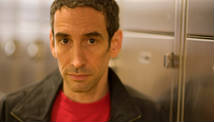Notre Dame star Manti Te'o
Notre Dame star Manti Te'o
Notre Dame star Manti Te'o
Notre Dame star Manti Te'o
Notre Dame star Manti Te'o
Notre Dame star Manti Te'o
Notre Dame star Manti Te'o
Notre Dame star Manti Te'o
Notre Dame star Manti Te'o
STORY HIGHLIGHTS
- Te'o's father had said his son, girlfriend had met at his home in Hawaii
- Manti Te'o is a hoax victim, Notre Dame says; university has hired an investigative firm
- Sports website Deadspin raises questions about the existence of his girlfriend
- In September, Te'o talked about losing his grandmother, girlfriend in the same week
(CNN) -- Notre Dame linebacker Manti Te'o said Wednesday he was the victim of a "sick joke" that had him and legions of fans believing in a "girlfriend" who may never have existed.
Te'o was the subject of an inspirational story that had him overcoming the deaths of his real-life grandmother and his "girlfriend" as his team marched toward the BCS National Championship Game.
Te'o released a statement and Notre Dame held a news conference Wednesday night after the sports website Deadspin published an article that called the girlfriend story a "hoax."
Last September and October, Te'o told interviewers the losses of the women, who reportedly died within hours of each other, inspired him to honor them with sterling play on the field.
"I miss 'em, but I know that I'll see them again one day," he told ESPN.
That and other media reports led to a gripping human interest story of determination. The girlfriend was identified as Lennay Kekua.
Jack Swarbrick, director of athletics at Notre Dame, told reporters that Te'o was the victim of an elaborate hoax. "And he will carry that with him for a while," Swarbrick said.
Notre Dame said the relationship between Te'o and the supposed girlfriend was exclusively online.
As part of the hoax, several meetings were set up, including at Te'o's home in Hawaii, but Kekua never showed, Swarbrick said.
Te'o's father, Brian, told the South Bend (Indiana) Tribune last fall that his son did have the opportunity to meet Lennay.
"They started out as just friends," Brian Te'o said, according to the newspaper. "Every once in a while, she would travel to Hawaii, and that happened to be the time Manti was home, so he would meet with her there. But within the last year, they became a couple."
According to Swarbrick, Te'o in early December received a call from a woman claiming to be his girlfriend and telling him she was not dead. Those calls continued but Te'o did not answer, Swarbrick said.
Te'o's grandmother did in fact die in September, according to Deadspin, but there is no Social Security Administration record of the death of the athlete's supposed girlfriend, described as a Stanford University student.
Stanford University's registrar's office told CNN that it has never had a student registered by Kekua's name or an alternative spelling.
"Outside of a few Twitter and Instagram accounts, there's no online evidence that Lennay Kekua ever existed," Deadspin contends. "There was no Lennay Kekua."
According to the website, Kekua, 22, had reportedly been in a serious auto accident in California and was later diagnosed with leukemia.
Photographs showing a young woman identified as Kekua in online tributes and news reports actually are photos from social media accounts of a 22-year-old California woman who is not named Lennay Kekua and does not have leukemia, according to Deadspin. The woman never met Te'o, it said.
Your opinion: What do you think?
After Notre Dame upset No. 10 Michigan State on September 15, Te'o told ABC about his late grandmother and girlfriend.
"They were with me. I couldn't do it without them," Te'o said. "I couldn't do it without the support of my family and my girlfriend's family."
"I'm so happy that I had a chance to honor my grandma and my family and my girlfriend," the Heisman Trophy runner-up said. "That's what it's all about, family."
Timothy Burke, co-author of the Deadspin article, told Miami sports radio host Dan Le Batard, "We got an e-mail last week saying something isn't right" with the girlfriend story.
Te'o, the runner-up for the Heisman Trophy, said Wednesday he "developed an emotional relationship with a woman I met online. We maintained what I thought to be an authentic relationship by communicating frequently online and on the phone, and I grew to care deeply about her."
In his statement reported by ESPN, the star said, "To realize that I was the victim of what was apparently someone's sick joke and constant lies was, and is, painful and humiliating.
"It further pains me that the grief I felt and the sympathies expressed to me at the time of my grandmother's death in September were in any way deepened by what I believed to be another significant loss in my life."
Notre Dame said it hired an independent investigative firm to look into the situation.
Swarbrick said the independent investigation found that the perpetrators were involved in "online chatter" indicating that it was a hoax, and Te'o was a victim.
"I will refer you to the documentary 'Catfish,'" the athletic director said. "It's ... about people tricking people online by pretending to be other people."
MTV broadcasts a show about such online trickery.
Swarbrick said he met with Te'o's family two days before Notre Dame played in the January 7 championship game and lost to Alabama. The linebacker is expected to be a first-round pick in the NFL draft this spring.
CNN's Steve Almasy, Amanda Watts and Phil Gast contributed to this report.














